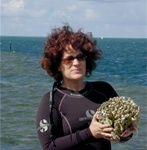Mary Hagedorn | |
|---|---|
 Mary Hagedorn working in the field with coral species | |
| Born | Mary Margaret Hagedorn September 12, 1954 |
| Education | Bachelor's and master's degrees from Tufts University, Ph.D from Scripps Institution of Oceanography at University of California |
| Known for | Pioneering and refining a new process in aquatic cryopreservation: the freezing of coral sperm and eggs for future use |
| Awards | Received the George E. Burch Fellowship in Theoretic Medicine and Affiliated Theoretic Sciences in 2000 and nominated as a Pew Fellow in Marine Conservation in 2005 |
| Scientific career | |
| Fields | Physiology, Marine Biology |
| Institutions | Research Scientist at National Zoological Park and Smithsonian Conservation Biology Institute; Affiliate Faculty at the Hawaii Institute of Marine Biology |
Mary Margaret Hagedorn (born September 12, 1954) is a US marine biologist specialised in physiology who has developed a conservation program for coral species, using the principles of cryobiology, the study of cellular systems under cold conditions, and cryopreservation, the freezing of sperm and embryos. [1]